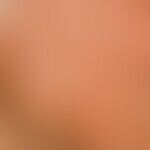Synonym(s)
DefinitionThis section has been translated automatically.
Self-tanning agents are cosmetic active ingredients that (independently) tan (colour) the skin without the influence of UV radiation. This skin tanning is merely a brown colouring of the horny layer of the skin (stratum corneum), which has no influence on the melanocyte activity. The melanocytes remain completely unchanged in contrast to the physiological tanning (pigmentation) caused by UV rays.
It is important for the behaviour in the sun that the colouring of the horny layer by self-tanning agents provides only a minimal sun protection effect (sun protection factor 1-2). This is why some self-tanning agents are combined with a sunscreen. Self-tanning agents are offered in cream bases, as emulsion, gel, spray or foam, depending on their field of application (face, body).
Self-tanning products for the face are mostly of creamy consistency. This enables a precise distribution. Self-tanners for the body are thinner in order to be able to distribute them more evenly and easily over larger areas.
General informationThis section has been translated automatically.
Dihydroxyacetone (DHA): DHA is a monosaccharide with three carbon atoms (triose). DHA reacts chemically with proteins and amino acids of the horny layer, which turns brown after about 3 to 6 hours.
Erythrulose: Erythrulose is a monosaccharide with 4 carbon atoms (tetrose). Erythrulose reacts like DHA with the proteins and amino acids of the horny layer. The discoloration of the skin is delayed after 2-3 days.
Often combinations of DHA and erythrulose are used.
Henna extracts: The essential compound is Lawson, 2-hydroxy-1,4-naphthoquinone, a red naphthoquinone dye. Lawson is present in the fresh plant as a glycosidic compound (hennoside).
Walnut shell extracts with the phylloquinone juglon. Juglon reacts with the keratin of the skin to form a brown dye. Juglon is stereosiomeric to Lawson.
Complication(s)This section has been translated automatically.
Allergological evaluation: Sensitization to the active ingredients is possible but rather rare.
Intensive use may cause yellow-brown stains on clothing which are difficult to wash out. Particularly affected are parts of the body which secrete more sweat (e.g. underarms) or where clothing rubs heavily (e.g. collar, crotch).
Handling self-tanning products requires some experience. An even, natural-looking tan is not always easy to achieve. The degree of tanning may vary on different parts of the skin, resulting in an unintentionally blotchy or streaky skin appearance.
Note(s)This section has been translated automatically.
With receding of the stratum corneum the tan disappears after a few days.
Areas with a thicker corneal layer (elbows, knees) turn a more intense brown. This is especially true for the palms of the hands if the substance is applied with the bare hands. Before applying the self-tanner, it is recommended to apply a greasy cream that prevents direct contact. Increasingly, seborrhoeic and actinic keratoses as well as skin areas with keratosis pilaris are also stained. This can lead to a blotchy overall appearance.
Self-tanners are also offered as an additive to conventional moisturizing cream.
With spray tanning, the body is sprayed evenly with self-tanning agent under a kind of shower, for example.




